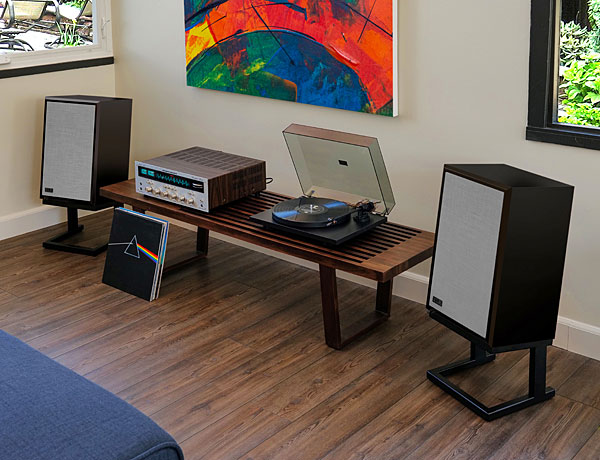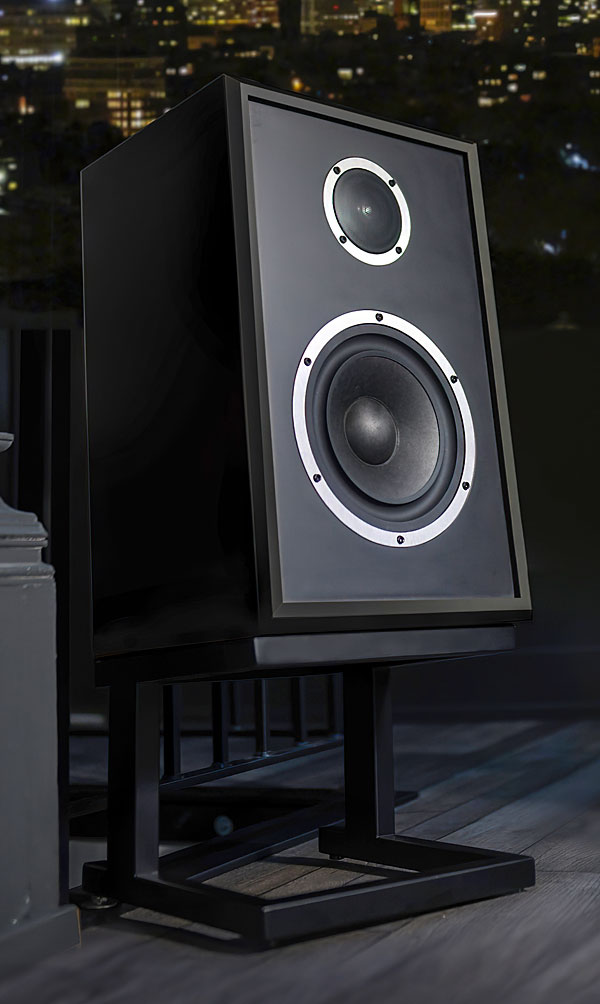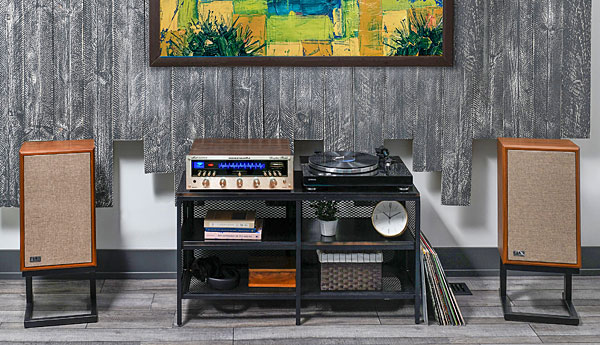Three for Three: KLH Model Three Review Page 2
Setup
I set up the KLH Model 3s about 9 feet apart, roughly 4 feet from the back wall, and angled inward at the primary listening seat. The tilt of the KLH's stands aimed the tweeters roughly at my seated ear height. But I had to tilt the stands a bit further backward, as my listening seat is a couple of inches taller than the typical listening chair.
I requested three Model 3s for the left, right, and center channels (thus the title of this review!). Why? Because on its stand, the Model 3 can be positioned in the center without blocking my TV or retractable projection screen (when the latter is in use). Viola… matched front channels! Of course, they can never be perfectly matched, as room positioning somewhat alters the sound of any speaker. But it's close, and this is the first time I've ever had the opportunity to have identical front-channel loudspeakers. Identical speakers across the front are easy with an acoustically transparent screen, but I prefer a solid surface screen for projector reviews.
I used a Denon AVR-X6700H AV receiver to drive all the loudspeakers, apart from the subwoofers. The rest of the system (surrounds, Atmos speakers, and subwoofers) was an eclectic mix. As I've mentioned in previous reviews, my large room provides limited deep bass support for full-range loudspeakers without subwoofers. The room also contributes annoying modal peaks between 100 and 200Hz, measured at the listening position. The only method I've found to correct these issues without significantly rearranging the room—not possible in my situation where the speakers must work with projection screens that can't be moved—is by using bass EQ. More on that is below.

Music
Driven full range without subwoofers, the KLH Model 3's deep bass wasn't overly impressive in my large, open-concept room. The good news was that my room's 100-200 Hz peaks, which I've mentioned in previous reviews, were down somewhat in level and less audible than usual. There wasn't a trace of boom or muddiness, and hard bass transients were as tight as a… umm… drum. But the bass fundamentals were either low in level or missing. This was clearly a room or setup issue, and neither could be changed.
I attempted to dial in Audyssey below 300 Hz, as is my usual practice (more on this in the Model 3 plus subwoofer section, below). But so much boost was required that the KLHs distorted when fed music with strong bass transients. Then I turned off Audyssey and simply increased the Bass control on my Denon AVR. Too much, and the overload raised its head again, but I settled on +2. That doesn't sound like much, and it isn't, but it did a surprisingly effective job restoring missing warmth and improving the KLHs' bottom end in my challenging room. It didn't throw down the gauntlet to a good subwoofer or two, but on music, the KLH 3 bass was surprisingly satisfying. Your situation may vary, and in a more modestly-sized space, you might not need any such tweak at all.
On a wide selection of music, the KLHs now performed impressively well. There was a small bump in the response around 2KHz, visible in my in-room measurements (see the Test Bench). On less-than-pristine recordings played back at high levels, this was clearly audible as an added sheen to the sound, but it was rarely intrusive. However, this is a highly resolving loudspeaker and may not be favored by listeners who prefer a warmer and less revealing sound.
On my favorite demo cuts, the Model 3s rarely put a foot wrong unless the recording was known to have issues. While organ recordings didn't blow out the walls on the subwoofer-less KLHs, they didn't sound unrealistically lean. Ditto on the consistently tight drums, whether the music was classical or jazz.

I often fall back on two compilation CDs from Dali loudspeakers that were available a few years ago but not any longer. They were mastered from a range of exceptional recordings with artists both familiar and (in the U.S.) unfamiliar. These include Toto, Bo Stief Dream Machine, Loreena McKennitt, Elvis, Holly Cole, Sinne Eeg, and Deadmau5. Every cut I played from these discs—and others as well—delivered.
I knew I'd need to add subwoofers to the Model 3s for movie playback, but I first tried it on the KLHs with music. The result wasn't disappointing. The KLH Model 3s blended seamlessly with my system's two subwoofers (SVS PB3000s). I also used Audyssey when the subwoofers were involved, but only below 300 Hz. While the results without the subs were rewarding on most music and would certainly be more so in a more modestly-sized room, it won't surprise any reader that even on music, adding a pair of large subwoofers raised things to another level. While on some music, it made little difference (as it should be with a proper setup), when you bring on the heavy artillery—drums, organs, electronica, on either music or movies—the overall improvements are impossible to miss.
Movies
In the subwoofer setup briefly addressed above, and as in my review of the KLH Model 5, I used the Denon AVR's Audyssey MultEQ XT32 room EQ together with Audyssey's optional Editor App. But only below 300 Hz. The KLH's native in-room response above that frequency was left alone, apart from an occasional +/-1 db setting on the Denon's treble control as needed by the source material. As before, the KLH's rear panel switch was set to Mid, and the grilles were installed.
I briefly noted above how adding a subwoofer or two helped the Model 3 with bass-heavy music in my large room. But it was a necessity with action-heavy movies. I won't apologize to those who may have tired of my using the film Oblivion in reviews. I know this soundtrack extremely well and have vivid expectations of what to expect from it. The subwoofer-ed Model 3s didn't disappoint in the slightest. Jack's opening narration was clean, clear and free of unnatural sibilance. Played back at room-filling levels, the crescendo accompanying the opening title was dynamic as you could want and then some. And while the crack of the lightning as Jack maneuvers his chopper through a storm was harshly bright, if you've ever had lightning strike within a mile or less of you, you'll know that this is a jump out of your skin experience—as it was here.
The crisp dynamics continued as Jack landed his chopper in a decaying stadium. There was a ton of deep bass here, and while the credit for this must go to the subwoofers, the Model 3s blended in flawlessly. Later, in Act 3, the music swells as Jack prepares to take Julia to the Tet. From there to the end, I had a hard time adjusting my critical reflexes, as this stretch of the film, to its end, is my favorite sequence. The electronic music score plays a big role, as it does elsewhere in the film, and nothing in the Model 3s performance let me down.

Blade Runner 2049 is a frightening experience for most subwoofers, and the Model 3s, again, blended with them perfectly. The soundtrack here ranges from big moments to subtleties, and it was in the latter moments, where the Model 3s needed no support from the subwoofers, that the KLHs excelled.
The extended version of Kingdom of Heaven (not the crippled theatrical release) is a sonic masterpiece. The audio flows gorgeously, from the subtlest scenes to the battles. And while the dialogue and effects are seamless on the Model 3s, it's in the music that the KLHs again demonstrated their superb performance. The film has been criticized, often with good reason, for its historical flaws. But if you're as sensitive as I am to how a score can enhance a film, this mattered little as the film's superb soundtrack, heard on the KLH Model 3s, blew away any such misgivings about the plot.
Conclusion
The audio world is full of fine speakers at under $1500/pair. Which is best? There's no reasonable answer to that often-asked question; it depends on your tastes and needs. The KLH Model 3 can compete head to head with any of them and offers a unique blend of superb sound, an included stand that will allow it to perform at its best, adjustability, and a unique, vintage look with up-to-date audio performance.
How does it compare with the KLH Model 5? While I reviewed that product, it's been a year or so since I've heard it and audio memory is far shorter than that. With its larger woofer and box, The Five offers more bass extension, but I still needed a sub or two on challenging film soundtracks, at least in my large room. But if you add a subwoofer, the Model 3 offers similarly high performance, and the money saved vs. the Model 5s can go to your subwoofer fund!
- Log in or register to post comments




























































